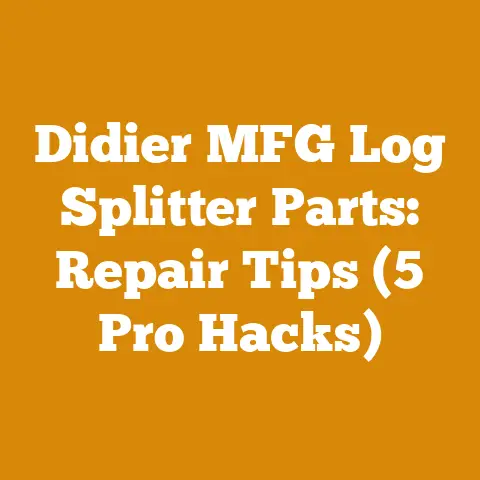DIY Trailer Light Tester (7 Easy Steps for Wood Hauling Safety)
Introduction: Banishing the Trailer Light Blues – A Wood Hauler’s Nightmare
I’ve been there, standing in the pouring rain, cursing under my breath at a trailer light that just won’t cooperate. You’re loaded up with a cord of freshly split oak, the sun’s starting to dip, and you realize your brake lights are on the fritz again. It’s a wood hauler’s nightmare. Trust me, I know the feeling intimately. After years of battling faulty wiring and flickering bulbs, I decided enough was enough. I needed a reliable way to test my trailer lights before hitting the road, especially when hauling heavy loads of wood. That’s when I developed this DIY trailer light tester. It’s simple, affordable, and, most importantly, it works! This guide will walk you through building your own, ensuring you stay safe, legal, and out of the clutches of Murphy’s Law.
DIY Trailer Light Tester (7 Easy Steps for Wood Hauling Safety)
This project is designed for anyone from the weekend warrior splitting wood for their fireplace to the small-scale logging operation. We’ll cover the basics, but also delve into some technical details that can really improve your safety and efficiency when hauling wood.
1. Gathering Your Arsenal: Parts and Tools
Before we jump in, let’s gather the necessary components. I’ve tried to keep this as budget-friendly as possible, using readily available parts.
- 12V Battery: A small 12V battery (like a motorcycle or lawnmower battery) is perfect. I personally use a sealed lead-acid battery from an old UPS. These batteries typically range from 7Ah to 12Ah. A fully charged 12Ah battery should provide enough power to test trailer lights for several hours.
- Alligator Clips: Five alligator clips, preferably color-coded (red, black, brown, yellow, green). These will be used to connect to the trailer light plug. I recommend getting clips with rubber boots for added insulation and safety.
- Inline Fuse Holder with Fuse: A 5-amp fuse will protect your battery and wiring from shorts. I once accidentally shorted a circuit without a fuse and nearly melted some wiring – a lesson learned the hard way!
- Wire: Approximately 10 feet of 16-gauge wire (stranded is best for flexibility). I prefer using different colors for each function (ground, tail lights, left turn, right turn, brake lights) to avoid confusion.
- Trailer Light Plug (Optional): A spare trailer light plug that matches the one on your vehicle. This makes testing even easier.
- Voltmeter/Multimeter (Optional): Useful for checking battery voltage and confirming continuity.
- Tools: Wire stripper, crimping tool (for alligator clips), electrical tape or heat shrink tubing.
Data Point: A 16-gauge wire is generally sufficient for trailer lights. However, for longer runs (over 20 feet), consider using 14-gauge wire to minimize voltage drop.
2. Mapping the Territory: Understanding Trailer Light Wiring
Before you start connecting wires, it’s crucial to understand the standard trailer light wiring configuration. This ensures you’re testing the correct circuits.
- White: Ground
- Brown: Tail Lights
- Yellow: Left Turn/Brake Light
- Green: Right Turn/Brake Light
- Blue (Optional): Electric Brakes (We won’t be using this for basic light testing)
Important Note: This is the standard wiring configuration in North America. However, wiring colors can vary in other regions. Always double-check the wiring diagram for your specific trailer.
3. Grounding is Key: Connecting the Ground Wire
- Crimp an alligator clip to one end of a length of black wire (approximately 2 feet).
- Connect the other end of the black wire to the negative (-) terminal of your 12V battery. Securely attach the connection.
- This alligator clip will be your ground connection.
Safety Tip: Always disconnect the ground wire first when working on electrical circuits. This minimizes the risk of accidental shorts.
4. Power Up: Connecting the Power Wire with Fuse Protection
- Cut a length of red wire (approximately 1 foot).
- Crimp one end of the red wire to the positive (+) terminal of your 12V battery.
- Connect the other end of the red wire to one end of the inline fuse holder.
- Connect another short length of red wire (approximately 6 inches) from the other end of the fuse holder to an alligator clip.
- Insert the 5-amp fuse into the fuse holder.
Why a Fuse? I can’t stress this enough. A fuse is crucial for protecting your battery and wiring. Without it, a short circuit can cause a fire or damage your battery. I learned this the hard way when testing a trailer with a faulty ground. The wiring started smoking before I could disconnect the battery.
5. Building the Test Leads: Preparing the Remaining Wires
- Cut three lengths of wire (approximately 2 feet each) – brown, yellow, and green.
- Crimp an alligator clip to one end of each wire.
- These will be your test leads for the tail lights, left turn/brake lights, and right turn/brake lights.
Pro Tip: Use different colored wires and alligator clips to easily identify each function. This will save you time and prevent errors.
6. Testing Time: Connecting and Evaluating the Lights
Now comes the fun part – testing your trailer lights!
- Connect the ground (black) alligator clip to the ground pin on your trailer light plug.
- Connect the power (red) alligator clip to the positive (+) pin on your trailer light plug (if applicable). Otherwise, leave this disconnected for now.
- Touch the brown alligator clip to the tail light pin on your trailer light plug. The tail lights should illuminate.
- Touch the yellow alligator clip to the left turn/brake light pin. The left turn/brake light should illuminate.
- Touch the green alligator clip to the right turn/brake light pin. The right turn/brake light should illuminate.
Troubleshooting:
- No Light: Check the fuse. If it’s blown, replace it. Also, ensure the ground connection is secure.
- Dim Light: Could indicate a corroded connection or a weak battery.
- Light Stays On: Could indicate a short circuit in the trailer wiring. Disconnect the battery immediately and inspect the wiring.
7. Finishing Touches: Organization and Storage
- Use electrical tape or heat shrink tubing to insulate any exposed connections.
- Organize the wires and alligator clips to prevent tangling. I use a small toolbox to store my tester.
- Label each alligator clip with its function (ground, tail lights, left turn, right turn) for easy identification.
Technical Specifications and Requirements: Digging Deeper for Wood Hauling Safety
Now that we’ve built the tester, let’s delve into some technical aspects that are crucial for safe and efficient wood hauling.
Wood Selection Criteria:
- Wood Type: Hardwoods (oak, maple, hickory) are denser and heavier than softwoods (pine, fir, spruce). Consider the weight capacity of your trailer when hauling hardwoods. Oak, for example, can weigh around 45-55 lbs per cubic foot when green. Pine, on the other hand, weighs around 25-35 lbs per cubic foot.
- Moisture Content: Green wood is significantly heavier than seasoned wood. Green oak can weigh up to 70 lbs per cubic foot. Firewood should have a moisture content of 20% or less for optimal burning. Use a moisture meter to check the moisture content of your wood.
- Log Dimensions: The length and diameter of the logs will affect the overall weight and volume of the load. I typically cut firewood to 16-inch lengths, which are manageable for most stoves.
- Cord Volume: A standard cord of wood is 4 feet high, 4 feet wide, and 8 feet long (128 cubic feet). Knowing the volume of your load is essential for calculating weight and ensuring you’re not exceeding your trailer’s capacity.
Data Point: A “rick” or “face cord” is a stack of wood 4 feet high and 8 feet long, but the width is variable. It’s important to clarify the width when buying or selling wood by the rick.
Tool Calibration Standards (Chainsaw):
- Chain Sharpness: A sharp chain is essential for efficient cutting and reducing strain on your chainsaw. I sharpen my chain after every few tanks of gas.
- Carburetor Adjustment: A properly adjusted carburetor ensures optimal fuel-air mixture for maximum power and efficiency.
- Chain Tension: Correct chain tension prevents the chain from derailing and reduces wear on the bar and chain.
- Bar Oiler: A functioning bar oiler is crucial for lubricating the chain and preventing overheating.
Safety Equipment Requirements:
- Personal Protective Equipment (PPE): Always wear safety glasses, hearing protection, gloves, and chainsaw chaps when operating a chainsaw.
- Trailer Safety Chains: Safety chains are required in most jurisdictions. Ensure they are properly connected and of sufficient strength to hold the trailer in case of a hitch failure.
- Tie-Down Straps: Use heavy-duty tie-down straps to secure the load of wood to the trailer. I recommend using ratchet straps with a working load limit that exceeds the weight of the load.
- Warning Lights/Reflectors: Ensure your trailer has functioning warning lights and reflectors to increase visibility, especially at night or in inclement weather.
Case Study: My Trailer Overload Mishap
I once hauled a load of green oak that I severely underestimated. I thought I was within the trailer’s weight capacity, but I was wrong. The trailer tires were visibly sagging, and the trailer was swaying dangerously at highway speeds. I immediately pulled over and redistributed the load, removing some of the wood. This experience taught me the importance of accurately calculating the weight of the load and knowing the trailer’s weight capacity.
Technical Limitations:
- Trailer Weight Capacity: This is the most critical factor. Exceeding the trailer’s weight capacity can lead to tire failure, axle damage, and loss of control. Check the trailer’s VIN plate for the Gross Vehicle Weight Rating (GVWR).
- Hitch Rating: The hitch must be rated to handle the weight of the trailer and the load.
- Tire Pressure: Maintain the correct tire pressure for the load. Underinflated tires can overheat and fail.
- Braking System: Ensure the trailer’s braking system is functioning properly, especially when hauling heavy loads.
Data Point: Most single-axle utility trailers have a GVWR of 2,990 lbs. However, the actual weight capacity may be less, depending on the weight of the trailer itself.
Industry Standards and Forestry Regulations:
- Department of Transportation (DOT) Regulations: Comply with all DOT regulations regarding trailer lights, brakes, and safety chains.
- State and Local Regulations: Be aware of any state or local regulations regarding wood hauling, such as permit requirements or restrictions on transporting firewood across state lines.
Practical Tips and Best Practices:
- Weigh Your Load: Use a truck scale to accurately weigh your trailer and load. This is the best way to ensure you’re not exceeding the weight capacity.
- Distribute the Load Evenly: Distribute the weight evenly over the trailer axle to prevent swaying and improve stability.
- Secure the Load Tightly: Use multiple tie-down straps to secure the load and prevent it from shifting during transport.
- Check Your Lights Before Each Trip: Use your DIY trailer light tester to check your lights before each trip.
- Drive Safely: Reduce your speed and increase your following distance when hauling heavy loads.
Cross-References:
- Moisture Content and Drying Times: The drying time for firewood depends on the wood type, log size, and climate. Generally, it takes 6-12 months for firewood to dry to a moisture content of 20% or less.
- Weight Capacity and Tire Pressure: Consult your trailer’s owner’s manual for the recommended tire pressure for different load weights.
Conclusion: Haul Safe, Haul Smart
Building this DIY trailer light tester is a small investment that can save you a lot of headaches and ensure your safety when hauling wood. Combine it with a solid understanding of wood selection, tool calibration, safety equipment, and industry standards, and you’ll be well on your way to hauling wood safely and efficiently. Remember, safety is paramount, especially when dealing with heavy loads and potentially hazardous equipment. Stay safe out there, and happy hauling!






